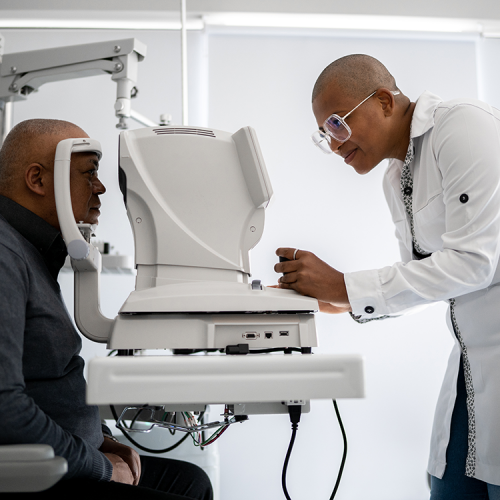Updated on December 12, 2022
Glaucoma’s impact on your vision can change the way you live your life. It’s important to know why glaucoma is called the “silent thief of sight.”
What is glaucoma?
Glaucoma damages the optic nerve in your eye. The optic nerve carries information from the eye to the brain, allowing you to see clearly. Glaucoma occurs when fluid builds up in your eye, increasing the eye’s pressure. This increase in pressure slowly damages the millions of fibers that make up your eye’s optic nerve.
There are two major types of glaucoma: primary open-angle glaucoma and angle-closure glaucoma.
- Primary open-angle glaucoma – This type of glaucoma is the most common type. It happens gradually as the eye does not drain fluid as well as it should, leading to pressure buildup and optic nerve damage.
- Angle-closure glaucoma – Also called “closed-angle glaucoma” or “narrow-angle glaucoma,” this type of glaucoma happens when the iris is close to the drainage angle, or the area of the eye that drains fluids and blocks the fluid from draining.
To see what it is like living with glaucoma, visit the Vision Simulator at versanthealth.com/visionsimulator.
What are the symptoms and signs of glaucoma?
Like many other eye diseases, there are little to no early symptoms of primary open-angle glaucoma. As a result, about half of Americans don’t know they have it. In most cases, glaucoma persists with no symptoms until irreversible damage is caused to the optic nerve and vision loss takes place. As the disease develops, blind spots will begin to appear in your peripheral (side) vision, causing an effect similar to tunnel vision.
Angle-closure glaucoma is less common in western nations but usually brings on a series of sudden symptoms. People with this disease may experience blurred vision, halos around lights, intense eye pain, nausea and vomiting. If these symptoms occur, it is necessary to visit the emergency room so steps can be taken to avoid permanent vision loss.
What causes glaucoma?
When fluid cannot drain properly from your eye, the pressure is not regulated and builds, damaging the optic nerve. As glaucoma damages the small fibers in the optic nerve, your vision worsens. If all of the fibers are gone, you will become blind.
While there are many theories as to what causes the fluid buildup in the eye, the exact cause is unknown. However, many risk factors have been linked to the disease, including:
- Age – People over 60 are at an increased risk for the disease.
- Genetics – Those with a family history of glaucoma are more likely to develop the disease.
- Medical Conditions – Diabetes, high blood pressure, and heart disease may increase the risk of developing the disease.
If you fall into any of the categories above, regular comprehensive eye exams are crucial for diagnosing and treating glaucoma before it causes permanent damage to your vision. Additionally, if you have diabetes, high blood pressure, or heart disease, regular visits to your doctor are necessary to make sure your health is under control.
How is glaucoma diagnosed?
Glaucoma is diagnosed by a comprehensive eye exam that tests your eye pressure, your eye’s drainage angle, your optical nerve, your peripheral vision, and the thickness of your cornea. Glaucoma tests are relatively quick and painless. Regular testing is important for everyone because of the lack of early symptoms of the disease.
How do you treat glaucoma?
The damage glaucoma causes will be permanent. However, certain measures can be taken to slow the progression of the disease and prevent further damage. Glaucoma is usually treated using daily eye drops that either decrease eye pressure or reduce the amount of fluid in the eye. Because glaucoma has no symptoms until it affects your vision, people are often tempted to discontinue taking their medication. However, regular use of eye drops is essential for their continued effectiveness.
Another form of treatment includes laser eye surgery called trabeculectomy. The eye care professional will use a laser to create a flap on the white of your eye to help drain the fluid from your eye. They will also create a bubble, which will help absorb the fluid from your eye. Your eye care professional may also implant a drainage tube that sends the fluid to a reservoir to be absorbed by blood vessels. After treatment, it is imperative to continue to see your eye doctor regularly to monitor the success of the treatment.
Glaucoma patients that leave the disease untreated will slowly lose their peripheral vision until it disappears. The best way to prevent vision loss from glaucoma is to see your eye doctor regularly. Studies have also shown that leading an active lifestyle can help reduce the chances of developing the disease.
Sources:
- https://www.allaboutvision.com/conditions/glaucoma.htm
- https://www.aao.org/eye-health/diseases/what-is-glaucoma
- https://www.aoa.org/patients-and-public/eye-and-vision-problems/glossary-of-eye-and-vision-conditions/glaucoma
- https://www.glaucoma.org/glaucoma/
- https://nei.nih.gov/health/glaucoma/glaucoma_facts
© 2022 Versant Health Holdco.
